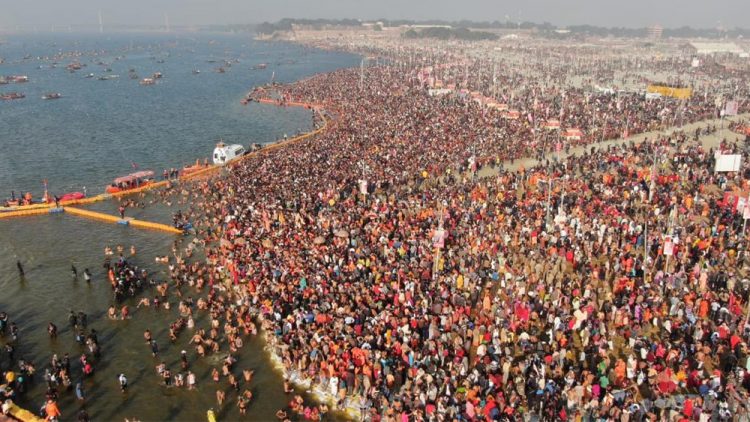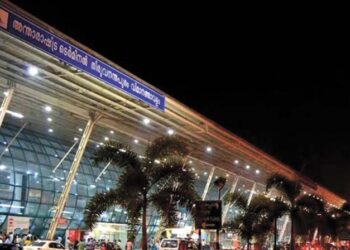It is, indeed, an amazing experience for a maiden visitor to the 2019 Maha Kumbh Mela. Also, for a
novice who has landed in Prayagraj for the Kumbh Mela, it is undoubtedly a unique and rather magnificent exercise.
In fact, when one hears about the word Kumbh Mela a picturesque vision of Triveni Sangam creeps into his/her mind. Vast expanse of the river bed spreading over 3,200 hectares of land has become virtually a temporary city. During the rainy season the entire area here goes under water. Where as, the temporary city, say official sources, has 250 km long roads and 22 pontoon bridges. The
Kumbh Mela area, for the first time, are brightened up with over 40,000 LED lights. The criss-cross roads built using long steel plates on the muddy-sandy soil make travel by vehicles until the permitted points comfortable. From this point the devotees have trek 6 to 8 kms to reach the bathing ghats.
Despite having the huge crowds flowing in and out like sea waves, every where it is clean. Except for the continuous announcements about missing persons the noise levels were bearable.
Those who have attended the Kumbh in the past said the management of the present Mela, especially the crowd management, is magnificent. Similarly, cleanliness of the river banks and the rivers is unparalelled. Govardhan Singh, a driver who picked us up from the airport said “for the first time in my memory I have seen such an incident-free and wonderfully managed neat and clean Kumbh Mela”. Everybody is taken by surprise and they wonder as to how such huge crowd is being handled with ease.
We left our hotel at 6 am. Mangal Nair, a Prayagraj born Malayalee, introduced to us by the then
Mizoram Governor, Kummanam Rajasekharan came to pick us up for taking the Holy dip on the
Mahasivarathri day at the Thriveni Sangam. A local young man, Mangal, having thorough knowledge
about the road net-work and traffic rules drove us smoothly to the last point up to which vehicles are
allowed. From there we were guided to the snan ghat trekking about 6 kms. All along the kilometers long banks of both Yamuna and the Ganga barricades have been erected in waist
deep water so as to restrict the devotees. At the banks of the river Yamuna Mangal has hired a small country-boat to take us to the Triveni Sangam. Tens of such boats with various capacities to carry more people were sailing. Motor-boats are not allowed in order to avoid polluting of the river water. Two rowers propelled our boat to the Sangam.
The water is very clean and blue in colour. At the Ganga-Yamuna Sangam also the water was very clean despite thousands are taking their bath. Our boat docked behind four boats which have arrived earlier with devotees and we moved over to the bathing ghat by walking through deck of the parked boats. It was around 10 am. Weather was pleasant with mild cold breeze punctuated by sun shine. We got into waist deep water. Many others men, women and children of different ages were taking their holy dip. We were taken by surprise to see such cold clean water contrary to the propaganda being spread earlier that the water is impure and unclean. We had taken as many as dips as possible. It is indeed a wonderful experience. We never dreamt of having a holy snan on the Mahasivarathri day at the Triveni Sangam during the Kumbh Mela. It is all the blessings of Kashi Vishwanath.
Returned to the boat. Changed our wet clothes and waited for others to return. The time took for returning to the embarkation point was about two hours. The oarsmen had to row about six kms on the route assigned for the return journey in order to ensure safety. On the way back the young rower took out an empty water bottle and got it filled with clean water from the Yamuna and was drinking to quench his thirst. He did not have any inhibitions to drink it. The water we took into our palm. It looked very clean with our naked eyes. All the passengers are compulsorily provided with life jackets. The rowers charged Rs500 per person. On normal days the charge ranges from Rs50 to 100 per person, they said.
UNESCO has already included Kumbh in the list of “Intangible Cultural Heritage of Humanity”.
In fact, at the confluence of the holy rivers, Ganga, Yamuna and Saraswathi converges the sea of
humanity filled with a sense of devotion and dedication. The air reverberates with the chanting of vedic mantras and elucidations of religious hymns emanating from the Pandals of the Akharas.
Added to it are proclamations of knowledge, Tatvamimamsa by rishis, spiritual music, mesmerising
sounds of instruments, holy dip in the sangam with utmost devotion all together fill the heart of devotees with immense joy. Also, prayers are offered at many divine temples exhibiting the greatness of Prayagraj Kumbh. “It is , indeed, a different world altogether where the sea of humanity moves like waves in the Ocean”.
One of the largest religious gatherings in the world has began on January 14 (Makar Sankanti day) and concluded on the Maha Sivarathri day on March 4, 2019. Sadhus of 13 akharas (seven Shaiva, three Vaishnava, two Udasina, and one Sikh) who traditionally
participate in the Kumbh Mela, are the first to take the holy bath known as ‘Shahi Snan’ on the first day of the 55-day-long Kumbh Mela.
“It is an ‘avismarniye’ (unforgettable) Kumbh. It is for the first time that representatives of 172 countries have participated in the Kumbh Mela, a mela official said. This time, the Kumbh Mela is spread over an area of 3,200 hectares as compared to 1,600 hectare area in the previous melas, he said. “Apart from being a Divya Kumbh, Bhavya Kumbh (divine Kumbh, grand Kumbh), this Kumbh Mela would also be remembered as Swachh Kumbh (Clean Kumbh), as more than 11,000 safai (cleaning) workers have been pressed into action,” officials said. It is also for the first time in the last 450 years that the devotees coming to the Kumbh have an opportunity to pray at ‘Akshay Vat’ and ‘Sarasvati Koop’, they said.
It is believed that an individual who takes the holy dip in the sacred waters relieves his/her ten generations from the cycle of rebirth, and hence, achieving salvation. Moreover, it is said that just by providing services to pilgrims at Prayag during Kumbh will help an individual to gain redemption from temptation.
Prayag is visited by tens of millions of pilgrims because of these beliefs. Saints, ascetics and their
followers pay their respect and perform various traditional rituals at Triveni sangam. The amazed
devotees line up to watch the rituals being performed. Although taking a dip in the sacred waters on all days of Prayagraj Kumbh beginning from Makar Sankranti (first day of the month of Magh, when the Sun enters Capricorn) is considered holy, yet there are some specific auspicious bathing dates. There are magnificent processions of saints and their disciples, and members of various Akharas (religious orders) take part in the ritual of Shahi Snan also known as ‘Rajyogi Snan’ at the start of Kumbh. Shahi Snan is the central highlight of Kumbh Mela and the most important part of the celebration. It is only after the Shahi Snan is complete, that people are
allowed to take the holy bath, in the belief that the people will get the added advantage of the essence of holy deeds and thoughts of the saints by taking the dip after them.
The six snans are taken on Makar Sankranti (1st Shahi Snan)– 14/15 January 2019
Paush Purnima–21 January 2019 ; Mauni Amavasya (Main Royal Bath 2nd Shahi Snan)–04 February 2019; Basant Panchami (3rd Shahi Snan)–10 February 2019; Maghi Poornima–19 February 2019 ; Maha Shivratri — 04 March 2019.
“Even though the Kumbh is organised at Triveni Sangam, it is related to entire Prayagraj area. Keeping this in view, the state government has beautified all the places directly or indirectly linked to the Kumbh. For the convenience of devotees and the tourists visiting the Kumbh, facility to reach there by air, road and river has been made for the first time”. The new Prayagraj airport was in fact, inaugurated just a couple of months before the beginning of the Kumbha mela , official sources said.
Unlike in the past unprecedented heavy security has been deployed at Kumbh along with 20 drones to keep a tab and over 800 CCTV and 200 balloon cameras have been installed to aid security. Giant LED screens have also been installed at different points, which is updating people on train, bus and ferries schedule. Taking safety precautions, tide timings are being announced in Bengali, Hindi and English. The Indian Coast Guard (ICG) has increased its surveillance along the coastline of West Bengal, an official said.
To boost security, the Kumbh Mela area has been brought under the surveillance of Integrated Control
and Command Centre and CCTV cameras. “Integrated Control and Command Centre of the smart city project has been dedicated to Prayagraj. The system will facilitate controlling and keeping safe the traffic movement and the crowd coming to the Mela,” said the officials.
As Kumbha Mela was due to be held in 2019, Prayagraj Mela Authority (PMA), a permanent body to
oversee the mela, was created by passing a bill in the UP Legislative Assembly. Around ₹4,200 crore
were allotted by the state government for the Kumbh 2019, over two times more than it had spent on the previous Kumbh held in 2013. Around 199 projects involving16 government departments were put under execution in four phases which included a six-lane bridge over the river Ganga and a four-lane railway over-bridge worth ₹275 crore.
The Public Works Department has to implement projects worth ₹430 crore including building an inner
ring road in the city. ₹210 crore would be spent on safe drinking water facilities and ₹60 crore to electrify the Kumbh area. Focus is also laid on solid waste management to ensure that the Ganga water is not contaminated. Moreover, widening and beautification of 18 roads and 25 road crossings has been completed well before the scheduled time.With meticulous monitoring most of the projects were completed on time. About six fly overs were completed in 12 to 16 months, Mr Mangal said. Where as , for the 2013 Kumbh held in Prayagraj, an amount spent was Rs. 1,214 crore.
Stampede is the usual tragedy that could befall where huge crowds gather in areas which cannot hold such large number of people. Several stampedes have occurred at the Prayagraj Kumbh Mela, in 1840, 1906, 1954, 1986 and 2013. The deadliest of these was the 1954 stampede, which left 800 people dead. In the last Kumbh Mela on February 10, 2013, a stampede broke out at Prayagraj railway station killing 42 people and injuring at least 45. So as to ensure that no such tragedy should take place in 2019, the Yogi Adithyanath goverment has taken adequate steps to control the crowd systematically and scientifically and, as a result, there were no stampedes and resultant casualties or injuries.
The administration has put in place Stampede Disaster management facilities with dedicated team of
doctors, paramedical staffs in case of burn injuries, drowning, stampede etc. with specialised kits. Every Police officer to be informed of traffic plan (including diversions and hold up areas) for prevention of diverting crowd in the wrong direction. Area in charge and inspectors to take stock of barricading arrangements every 2 hours every day to ensure movement of crowds in defined directions. Round the clock, CCTV monitoring of identified high-risk areas for diversion of crowd with appropriate utilisation of public announcement system. Stock emergency equipment and supplies at all high-risk areas such as first aid kits, barriers, torches etc.
Legends Maharshi Markandeya in ‘Matsya Purana’ told Yudhishtra that this place is specifically protected by all the Gods. Residing here for a month and practicing complete asceticism, remaining celibate and duly performing oblations for his deity and ancestors fulfils all the desires. It is believed that an individual who takes the holy dip in the sacred waters relieves his/her ten generations from the cycle of rebirth, and hence, achieving salvation. Moreover, it is said that just by providing services to pilgrims at Prayag during Kumbh will help an individual to gain redemption from temptation.
Prayag is visited by tens of millions of pilgrims because of these beliefs. Saints, ascetics and their followers pay their respect and perform various traditional rituals at Triveni sangam. The amazed devotees line up to watch the rituals being performed.
According to Hindu mythology, Vishnu dropped drops of amrita (the drink of immortality) at four places, while transporting it in a kumbha (pot). These four places, including Allahabad, are identified as the present-day sites of the Kumbh Mela. The river-side fair at Allahabad is centuries old, but its association with the kumbha myth and a 12-year old cycle dates back to the 19th century. The priests of Allahabad borrowed these concepts from the Haridwar Kumbh Mela and applied it to their local Magh Mela, an annual celebration. The Magh Mela probably dates back to the early centuries CE, and has been mentioned in several Puranas .A common conception, advocated by the akharas, is that Adi Shankara started the Kumbh Mela at Prayag in the 8th century, to facilitate meeting of holy men from different regions. The 16th century Ramcharitmanas of Tulsidas mentions the mela in Allahabad as an annual one, but does not contain any reference to a 12-year cycle.
Tabaqat-i-Akbari (c. 1590s) of Nizamuddin Ahmad also mentions that the mela as annual. It states that after the rabi harvest, Hindus came to the Triveni Sangam in such large numbers that the jungles and the plains were not sufficient to hold them. Ain-i-Akbari, also from the 16th century, mentions that Allahabad is especially holy in the month of Magha. It is difficult to determine the exact year in which the Magh Mela was first celebrated as a Kumbh Mela. The 1870 fair at Allahabad is the earliest fair that is described as a “Kumbh Mela” by contemporary sources. The previous Kumbh Mela would have been scheduled in 1858; but that year, no fair was held in Allahabad because of disturbances resulting from the 1857 uprising.











